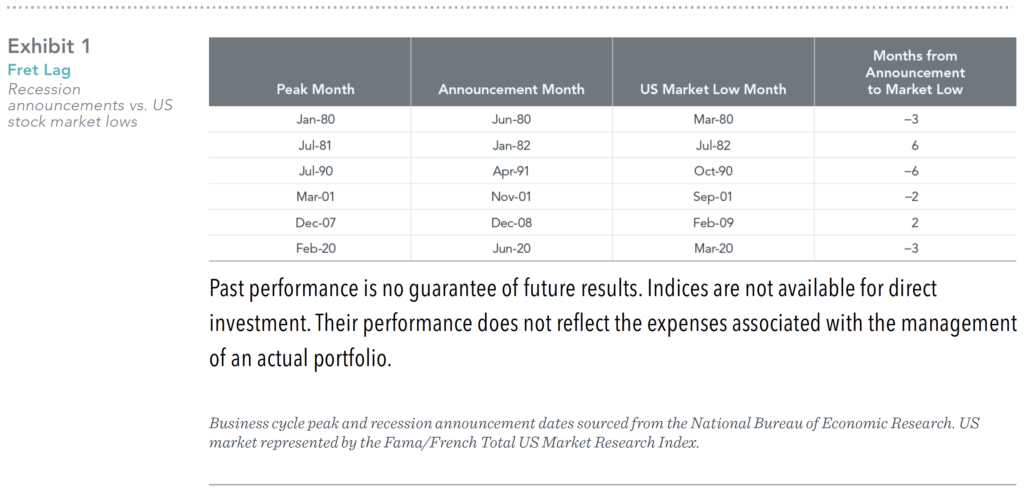Just two years removed from the last US recession, negative stock returns and aggressive US Federal Reserve interest rate hikes have many investors concerned we are headed for another big “R”—if we’re not already there. But recessions are always identified with a lag. By the time one is called, the worst of its impact on markets has usually passed.
The National Bureau of Economic Research (NBER) identifies phases of the business cycle using a bevy of indicators, such as consumption and income data, employment rates, and gross domestic product growth. None of these measures has been consistently dominant in the determination of economic conditions, and certainly past US recessions have come in all shapes and sizes. Recessions are therefore named retroactively, with the benefit of hindsight (and additional economic data that may be available with a lag).
Because recessions are proclaimed with a delay, rather than in real time, markets are often on the way toward a recovery by the time of the announcement. As shown in Exhibit 1, the stock market had already bottomed out prior to the announcement month in two-thirds of recessions since 1980.<sup/”>1In 2020’s recession, for example, the market’s low point came in March, three months before the announcement in June 2020. The takeaway for investors? If and when a recession is declared, we think the most sensible approach is to remain disciplined with one’s asset allocation; reducing exposure to stocks at that point may lead to missing out on brighter days ahead.

1. Prior to 1979, the NBER did not formally announce recessions.
GLOSSARY
Gross domestic product: The total value of goods and services produced by, for example, a country over a set period of time.
DIMENSIONAL FUND ADVISORS AND TRIAD ADVISORS ARE NOT AFFILIATED.
The information in this document is provided in good faith without any warranty and is intended for the recipient’s background information only. It does not constitute investment advice, recommendation, or an offer of any services or products for sale and is not intended to provide a sufficient basis on which to make an investment decision. It is the responsibility of any persons wishing to make a purchase to inform
themselves of and observe all applicable laws and regulations. Unauthorized copying, reproducing, duplicating, or transmitting of this document are strictly prohibited. Dimensional accepts no responsibility for loss arising from the use of the information contained herein.
“Dimensional” refers to the Dimensional separate but affiliated entities generally, rather than to one particular entity. These entities are Dimensional Fund Advisors LP, Dimensional Fund Advisors Ltd., Dimensional Ireland Limited, DFA Australia Limited, Dimensional Fund Advisors Canada ULC, Dimensional Fund Advisors Pte. Ltd, Dimensional Japan Ltd., and Dimensional Hong Kong Limited. Dimensional Hong Kong Limited is licensed by the Securities and Futures Commission to conduct Type 1 (dealing in securities) regulated activities only and does not provide asset management services.
Dimensional Fund Advisors LP is an investment advisor registered with the Securities and Exchange Commission.
RISKS
Investments involve risks. The investment return and principal value of an investment may fluctuate so that an investor’s shares, when redeemed, may be worth more or less than their original value. Past performance is not a guarantee of future results. There is no guarantee strategies will be successful.
Share this article:
Investor Risk Capacity Survey
Receive Your Risk Number
Take a 5-minute survey that covers topics such as portfolio size, top financial goals, and what you’re willing to risk for potential gains. We’ll use your responses to pinpoint your exact Risk Number to guide our decision-making process.


